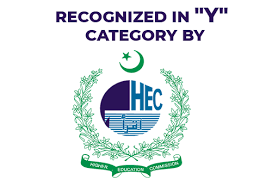Efficacy of Cognitive Behavioral Play Therapy (CBPT) For Children with Attention Deficit Hyperactivity Disorder (ADHD)
Abstract
 Abstract Views: 859
Abstract Views: 859
Exploratory research was designed to study the effectiveness of Cognitive Behavioral Play Therapy (CBPT) for children with Attention-deficit Hyperactivity Disorder (ADHD). It was hypothesized that CBPT will markedly reduce inattentiveness in children with ADHD. A sample of 10 children (5 girls and 5 boys) was selected from Army Special Education Academy Fort Road Rawalpindi Cantt ages ranged from 08-15 years. Swanson, Nolan, and Pelham Parent or Teacher Rating Scale (Bussing et al., 2008) was used to screen out inattentiveness in children. Paired sample t-test was used to check the significant change in the behaviors of the children and the overall effectiveness of the cognitive-behavioral play therapy. The difference in the symptoms for pre and post-test measures was found to be significant for symptoms of inattention in children with ADHD. It was also found that cognitive-behavioral Play Therapy is effective for reducing inattentiveness in children with Attention Deficit hyperactivity disorder.
Downloads
References
Bana, S., Sajedi, F., Mirzaie, H., & Rezasoltani, P. (2017). The efficacy of cognitive behavioral play therapy on self-esteem of children with intellectual disability. Iranian Rehabilitation Journal, 15(3), 235–242.
Brandt, V., Kerner Auch Koerner, J., & Palmer-Cooper, E. (2019). The Association of Non-obscene Socially Inappropriate Behavior with Attention-Deficit/Hyperactivity Disorder Symptoms, Conduct Problems, and Risky Decision Making in a Large Sample of Adolescents. Frontiers in psychiatry, 10(660), 1-6. https://doi.org/10.3389/fpsyt.2019.00660
Bussing, R., Fernandez, M., Harwood, M., Hou, W., Garvan, C. W., Eyberg, S. M., & Swanson, J. M. (2008). Parent and teacher SNAP-IV ratings of attention deficit hyperactivity disorder symptoms: Psychometric properties and normative ratings from a school district sample. Assessment, 15(3), 317-328. https://doi.org/10.1177/1073191107313888
Cordier, R., Vilaysack, B., Doma, K., Wilkes-Gillan, S., & Speyer, R. (2018). Peer Inclusion in Interventions for Children with ADHD: A Systematic Review and Meta-Analysis. BioMed Research International, 2018, 1–51. https://doi.org/10.1155/2018/7693479
Drewes, A. A. (2009). Blending Play Therapy with Cognitive Behavioral Therapy: Evidence-Based and Other Effective Treatments and Techniques. John Wiley and Sons, Inc.
Fabiano, G. A., Pelham Jr, W. E., Coles, E. K., Gnagy, E. M., Chronis-Tuscano, A., & O'Connor, B. C. (2009). A meta-analysis of behavioral treatments for attention-deficit/hyperactivity disorder. Clinical Psychology Review, 29(2), 129-140. https://doi.org/10.1016/j.cpr.2008.11.001
Feizollahi, J., Sadeghi, M., & Rezaei, F. (2020). The Effect of Cognitive Behavioral Play Therapy and Its Integration with Parental Management Training on Symptoms of ADHD in 7-11 Year Old Children: A Quasi-Experimental Study. Journal of Rafsanjan University of Medical Sciences, 19(2), 155-172.
Fred, K. & Berger, M. D. (2015). U.S. National Library of Medicine. Attention deficit hyperactivity disorder. https://medlineplus.gov/ency/article/001551.htm
Garber, J., Frankel, S. A., & Herrington, C. G. (2016). Developmental demands of cognitive behavioral therapy for depression in children and adolescents: Cognitive, social, and emotional processes. Annual Review of Clinical Psychology, 12, 181–216. https://doi.org/10.1146/annurev-clinpsy-032814-112836
Halder, S., & Mahato, A. K. (2019). Cognitive Behavior Therapy for Children and Adolescents: Challenges and Gaps in Practice. Indian Journal of Psychological Medicine, 41(3), 279–283. https://doi.org/10.4103/IJPSYM.IJPSYM_470_18
Hassani, R., Mirzaeean, B., & Khalilian, A. R. (2013). Effectiveness of cognitive behavior-based play therapy on anxiety and selfsteem of children with attention deficit/hyperactivity disorder (ADHD) children. Journal of Psychology, 8(29), 163-80.
Kaduson, H. G., Cangelosi, D., & Schaefer, C. E. (Eds.). (2019). Prescriptive play therapy: Tailoring interventions for specific childhood problems. Guilford Publications.
Knell, S. M., & Dasari, M. (2009). CBPT: Implementing and integrating CBPT into clinical practice. In: A. A. Drewes, (Ed). Blending Play Therapy with Cognitive Behavioral Therapy: Evidence Based and Other Effective Treatments and Techniques. Hoboken, New Jersey: John Wiley & Sons.
Malik, T. A., Rooney, M., Chronis-Tuscano, A., & Tariq, N. (2017). Preliminary efficacy of a behavioral parent training program for children with ADHD in Pakistan. Journal of Attention Disorders, 21(5), 390-404. https://doi.org/10.1177/1087054714524158
Matson, J. L. (2019). Handbook of intellectual disabilities: Integrating theory, research, and practice. Cham: Springer.
Robinson, A., Simpson, C., & Hott, B. L. (2017). The effects of child-centered play therapy on the behavioral performance of three first grade students with ADHD. International Journal of Play Therapy, 26(2), 73–83. https://doi.org/10.1037/pla0000047
Russ, S. W. (2003). Play in child development and psychotherapy: Toward empirically supported practice. Routledge.
Saleem, S., & Mahmood, Z. (2011). Development of a scale for assessing emotional and behavioural problems of school children. Pakistan Journal of Social and Clinical Psychology, 9, 73-78.
Swanson, J. M. (1981). The SNAP rating scale for the diagnosis of attention deficit disorder. Paper presented at the meeting of the American Psychological Association; Los Angeles.








